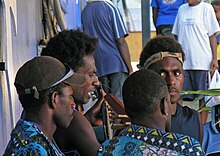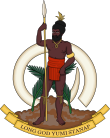Culture of Vanuatu
This article presents an overview of the culture of Vanuatu.
Social system and customs

Vanuatu culture retains a strong diversity through local regional variations and through foreign influence. Vanuatu may be divided into three major cultural regions. In the north,
Young men undergo various coming-of-age ceremonies and rituals to initiate them into manhood, usually including circumcision.
Music
Traditional music (known in
The large slit gongs which symbolize Vanuatu belong to these traditional instruments; they were most often used as musical drums to accompany certain dances, but also sometimes – though seldom – as a ritual means of communication; although widespread throughout Vanuatu, they are used vertically only in central areas of the archipelago (mainly on Ambrym). Traditional music is actually a very general cover term encompassing a wide and complex variety of musical genres known by every local community – in a way very similar to the vague term classical music of Western societies.

Another musical genre that has become widely popular during the 20th century in all areas of Vanuatu, is known as string band music. It combines guitars, ukulele, bush bass and popular songs.
More recently the
Literature
There are few prominent ni-Vanuatu authors. Women's rights activist Grace Mera Molisa, who died in 2002, achieved international notability as a very descriptive poet.
Painting

One of the most important contemporary artists of Vanuatu is Aloi Pilioko who created the impressive colourful relief on the post office in Port Vila.[2] Another remarkable wall painting can be seen on the administration building opposite the market hall in Port Vila.
Sport
Languages
There are three official languages: English, French, and Bislama. Bislama is a pidgin language, and now a creole in urban areas, which essentially combines a typically Melanesian grammar with a mostly English vocabulary. It is the only language that can be understood and spoken by the majority of Vanuatu's population as a second language. In addition 113 indigenous languages are still actively spoken in Vanuatu.[1]
The density of languages per capita is the highest of any nation in the world, with an average of 2,000 speakers per language. All of these vernacular languages belong to the Oceanic branch of the Austronesian family.
Religion
Traditional religion
Before Christianity, the indigenous religion of Vanuatu was inherited from Oceanian and Melanesian traditions.[4] Missionaries often called this pre-Christian religion “pagan” or “heathen” in English, and as “times of darkness” in the country's local languages,[5][6]: 207 or in Bislama (taem blong tudak).[7]: 86 [8]: 140
The traditional religion, sometimes considered a form of
Concepts central to the traditional religion include
: 218–222Grade-taking ceremonies, which existed throughout Vanuatu, were associated with the indigenous religion, and with the transmission of mana.
Many aspects of the traditional religion have survived until today, in parallel with the adoption of Christianity, at least in some rural areas of Vanuatu.[7]: 86 [8]
Christianity

Today,
Others are the Seventh-day Adventist Church, the Church of Christ, Neil Thomas Ministries (NTM), as well as many other religious sects and denominations.
Other religions
Because of the modernities that the military in
is still large, and has adherents in the parliament.Also on Tanna is the
Islam in Vanuatu is made up of about 200 converts and growing fast.[17] It was introduced by Hussein Nabanga who converted to Islam while training to be a Christian missionary.
Cuisine
The cuisine of Vanuatu (aelan kakae) incorporates
See also
References
- ^ a b "Culture of Vanuatu". Vanuatu Tourism. Archived from the original on 2007-05-20. Retrieved 2007-07-16.
- ^ Michael Brillat: Südsee, p. 52. München 2011
- ^ Vanuatu announce major sponsor – Beyond the Test World at Cricinfo at blogs.cricinfo.com
- ^ ISBN 978-0-02-909880-6.
- ^ See entry toglolqōn̄ in A. François’ Cultural dictionary of the Mwotlap language (2023).
- ^ a b c d François, Alexandre (2013), "Shadows of bygone lives: The histories of spiritual words in northern Vanuatu" (PDF), in Mailhammer, Robert (ed.), Lexical and structural etymology: Beyond word histories, Studies in Language Change, vol. 11, Berlin: DeGruyter Mouton, pp. 185–244
- ^ a b Lightner, Sara B. (2007). Ples blong olgeta sista: Ni-Vanuatu catholic sisters navigating places and spaces (Masters thesis). Honolulu: University of Hawai'i at Mānoa.
- ^ ISBN 978-90-04-21723-2. Retrieved 2023-04-28.
- ISBN 9780486202587.
- ^ JSTOR 2843828. Retrieved 2019-02-01.
- ^ ISBN 9782854300642.
- JSTOR 3629696.
- JSTOR 40332069.)
{{cite journal}}: CS1 maint: date and year (link - . Retrieved 2022-07-11.
- ^ Fifty facts about the Duke of Edinburgh Archived July 25, 2008, at the Wayback Machine 25 January 2002
- ^ Cf. Felix Speiser in Ethnology of Vanuatu. London: C Hurst, 1998, p.310.
- ^ Ben Bohane (2007-06-29). "Green Moon Rising: Islam Is Spreading In Melanesia". Pacific Magazine. Archived from the original on 2007-10-10. Retrieved 2007-07-16.
- ^ a b c d e The Peace Corps Welcomes You to Vanuatu Archived 2008-09-10 at the Wayback Machine. Peace Corps (May 2007). This article incorporates text from this source, which is in the public domain.

